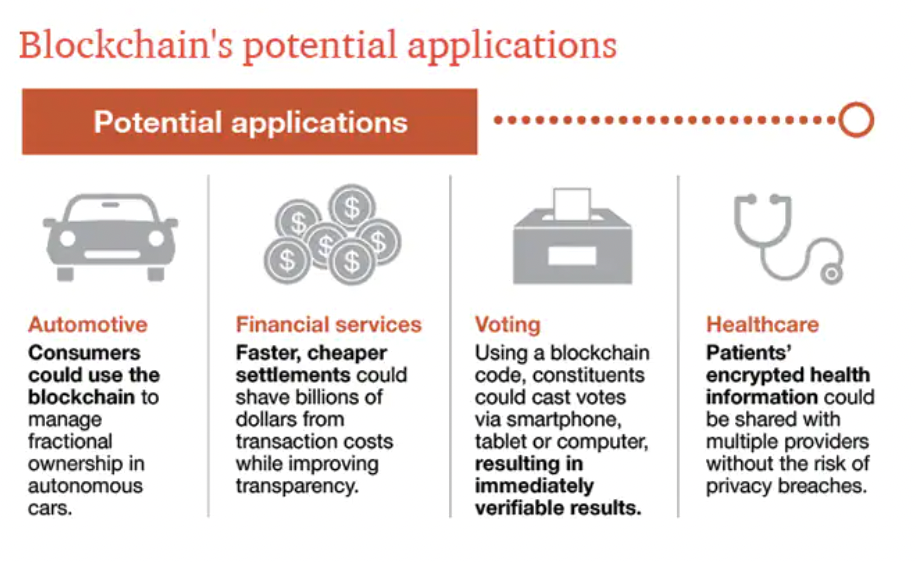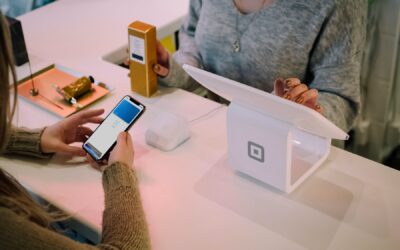The way that we work and use technology has evolved over the last decade so it comes as no surprise that the methods of data storage have evolved alongside that. Traditional methods of data storage, such as the cloud and physical drives, have often warranted the ability to be subject to modification and errors. This, in turn, could mean that there is a risk of error in the information or data that is stored using these types of methods. The introduction of blockchain is very much a newly implemented method of data storage that is being seen more and more across the board within different types of businesses.
What is Blockchain?
Blockchain is a type of database that is shared by different parts of a computer network. It is essentially a type of technology that stores transactional data in the most accurate way possible. As a database, these data entries are stored electronically in a digital format and is best known to run parallel with cryptocurrency systems. The innovation of blockchain itself guarantees fidelity and security without the need for going through third parties.
A key concept of blockchain technology is how it is structured compared to other digital forms of data storage. This is a key and primary difference. A blockchain lends the nature of its storage by its name, it is indeed a chain of sorts. A blockchain collects information together in groups which are known as blocks. These blocks have certain storage capacities and are linked to other blocks of information which in turn forms the chain of information and data. Once new information is added, it continues to build on the chain of blocks and is strung together.
The strung-together nature of a blockchain lies in contrast to typical data which is a table. These are known as decentralised blockchains because they are immutable in nature. This makes the nature of a blockchain irreversible and unable to be changed once data has been stored. It is essentially a timeline of data storage, which is so popularly used with transactional data. Each block is accurately time-stamped once it is added to the chain. This highlights the accurate nature of this type of data storage and becomes a ledger for all the data types that have come through the blockchain and resolved any discrepancies.
The goal of blockchain is to allow for data storage, but not for data editing, which makes it like no other storage option before blockchain. Blockchain can also be known as a distributed ledger technology or DLT. This type of technology refers to technological infrastructure that upholds an immutable manner which is what blockchain is. It cannot be edited and it cannot be changed.
The history of blockchain lies in a research proposal that came about in 1991. Its widespread application in Bitcoin only came about in 2009, but the concept of blockchain was a concept that very much predated this. It seems that in the modern-day, the application opportunities of bitcoin have become more and more widespread.
The typical transaction process when it comes to using blockchain is a new transaction is entered and then scattered to add to the appropriate block and added to the correct timeline and chain.

(Image Source: Investopedia)
What is Blockchain encryption and how does it work?
The secure nature of blockchain means that the encryption of blockchain technology is very much a heightened security measure. Blockchain encryption is the prevention of sensitive information from getting into the wrong hands and being misused or forged. Because the nature of blockchain is very mich lies in data not being able to be edited or removed so the data must be very much protected. All the data is verified, uploaded and secured by way of encryption. The way that blockchain and encryption security works are based on an algorithm that must be solved as a way for a piece of data to be verified when it comes to being added to a blockchain. This ensures that security measures are taken before the stay is even stored.
The encryption itself, when it comes to blockchain, lies in the mathematics behind the mining network. Encryption is the process of converting information or data into a code especially to prevent unauthorised access. Encryption uses more mathematical techniques along with passwords and keys used to decrypt the information and heavily relies upon an algorithm to make original information unreadable. The process itself converts the original information and data into plaintext which is an alternative text which allows it to be encrypted and secure. When an authorised user needs to access or read the data in a blockchain, they can decrypt it by using a key. This will then convert the plaintext back to the original text to be accessed, and this is very much the case with blockchain.
The way that encryption works are based on the strength of an encryption security key. In the latter part of the 20th century, web developers used 40-bit encryption which was easily broken through so over the years the layers and security of encryption have gotten more and more complicated as a way to protect data even further than ever before. Many corporations, in the past, have failed to encrypt their data in a way that means they have left their databases open to sensitive information and has been a downfall of their business. The use of blockchain and the encryption within that focuses on using encryption and the blocks to protect data in the most secure way that it possibly can.
There are several methods of encryption that exist, this is known as Symmetric Encryption Cryptography and this type of encryption uses the same secret key to encrypt a raw message at the source and then send the encrypted version to the recipient which is decrypted once it reaches its destination. The use of numbers and combinations to represent letters from the alphabet makes it so that the receiver will be able to decrypt what any message is saying. For example, ‘01’ could be ‘A’, ‘02’ could be ‘B’ and would continue on in this manner to be able to be deciphered. The word ‘hello’ would be encrypted as ‘0805121215’ and the receiver would have to know the encryption methodology to be able to understand anything that was sent to them or retrieved from a blockchain. There are many complex variations of encryption methodology, and presents itself with the disadvantage of the key being shared widely.
Another form of encryption is Asymmetric Encryption Cryptography which uses two different keys, one which is public and one which is private. The two separate keys are used for both encryption and to decrypt any data. The use of the private key is only known by the owner and any data set can be decrypted using the receiver private key. This is considered an even more secure version of blockchain than Symmetric Encryption Cryptography because fewer people have access to the key that is needed to be able to decrypt something.
What do we use Blockchain for?
Blockchain, as it stands, is an interesting way to store data so it can be used in many different ways. The nature of the blockchain itself means that data provides an accurate way of showing what transactions and operational actions have taken place with the understanding that they cannot be changed. This is why more and more businesses are opting for blockchain and upholding the security of their data. The term blockchain has almost become a pairing with cryptocurrency, but it is forgotten that blockchain was very much a form of data storage before then.
Cryptocurrency
One of the most prominent ways that blockchain is used is for the use of cryptocurrency. As blockchain records every transaction through a business, the use of this form of stays storage is used for cryptocurrency. Cryptocurrency such as Bitcoin provided a platform for blockchain to become elevated and considered across different sectors and business types. The use of blockchain within cryptocurrency works by ensuring that the technology is secure and anonymous. The transparency of blockchain means that bitcoin can very much operate on an anonymous basis and provide secure transactions of its use. It is an advanced tool for record-keeping, which makes it the perfect transactional software to use for a cryptocurrency or transactional business or product.
The cryptocurrency boom has meant that more and more people have become aware of what blockchain is and what it means to use it. The basics of blockchain are being looked into and tested to see how they can be used across an array of industries. It is a trusted transaction network in which people have access to a range of different assets including currencies. The increased investments into cryptocurrency just go to show that it isn’t just the currency itself that has affected the financial markets but the software and data systems that are associated and reliant on it.
Digital Voting
Digital Voting is a way that voter fraud could be reduced by using blockchain technology in a new way. The blockchain offers the option to vote digitally and is more effective than other standard methods of digital voting because it holds more transparency and would be truly accurate because of its unchangeable nature. Regulators would be able to see any changes that were made if any type of fraud had been attempted.
Food Safety
Food safety is another way that blockchain technology might be being underutilised. The use of the blockchain would be able to detect and trace your food back to the source. This would include how the food and produce were being transported to any preparation areas that may have been used to create a product that you may be consuming. This would be an excellent method and way to track and trace any foodborne viruses, illnesses or a particular contaminate. This would make the food production industry streamline any issues they could be having with a certain product line and rectify them quickly.

(Image Source: PwC)
Wills and Inheritance
Blockchain technology may be a way for any assets or wealth to be managed in a secure way. The way that this technology could be used posthumously and every decision is documented with no risk of there being any changes made or Rather than creating a paper will, people can store and organise their assets in blocks. This could then be used as a basis to split what is needed at a certain time rather than being fought over or ownership is given to someone that wasn’t explicitly outlined in the will. To reduce any misguidance of any assets or money, the blockchain network can be home to all the demands to action before death and ensure they are done properly. For example, if you leave a portion of wealth to a grandchild and they can only access it when they are 22 years old, then the legally binding nature of the blockchain will ensure that they will get it when they are 22 and not be withdrawn early. This will leave very few questions and confusion after death for the recipients or anyone receiving an inheritance.
Tracking Prescription Drugs and Medical Recordkeeping
Using blockchain to track prescription drugs and keeping their delivery of them transparent can mean that authentication of drugs will reduce the risk of any counterfeit goods being used. From batch numbers to keeping track of the ingredients used in certain medications, by using blockchain, issues can be identified with a particular bath of drugs that may hold some inconsistency with other drugs in that batch. Merck is currently trialling the use of blockchain in a pharmaceutical sense. In more of a medical sense, blockchain can be used to store patient data in a secure and encrypted way and any changes made to records will be viable on the blockchain so even the smallest of medical visits will be recorded and the location and ailment also.
Copyright and Royalty Protection
Another way that blockchain technology may be underutilised is through copyright and royalty protection. As people’s access to the internet is getting easier and easier, the ownership of certain content has gone through the wringer. With blockchain technology, the true identity of who pens a certain piece of content can be established. It would ensure that an artist gets what they drive from a piece of content that they created and are not discredited because ownership could not be proved. Blockchain technology would remove all ambiguity and issues regarding this matter.
Supply Chain and Logistics Monitoring
The use of blockchain technology with supply chain and logistics will allow certain operational structures to be streamlined and be made more accurate. The block nature of this type of data storage means that any type of change in logistics will be viewed by all the people who have access to the data and of course, mean that if there are any problems with supply or the logical side of an operation then it can be pinpointed as to what has caused that problem and therefore solve it in a faster way.
NFT Marketplaces
An NFT stands for non-fungible token and is essentially a modern-day collectable. It is a digital asset that is assigned to prove ownership of that particular token. It is a unique identifier that essentially grants someone ownership and very much isn’t interchangeable with other non-fungible tokens because each token has value tied to its uniqueness. You could take the example of a five-pound note if it was exchanged with another five-pound note, you would still be left with a five-pound note, but if you swapped a piece of artwork for a vintage vinyl the exchange would result in different things making it non-fungible. This is how it works with blockchain and NFTs. When it comes to the use of blockchain with NFT’s, the storage of them is that they are stored in a network that ensures verification is the key to accessing this data. The purchase and exchange of NFT’s can be traced because of the nature of blockchain. Different types of digital goods can be digitalised, including artwork and music. There is a conveyance of ownership through the NFT that is added to a blockchain and remains there. The licensing rights of these digital artworks are all stored in the blockchain.
Real Estate Processing Platform
The use of blockchain can be used in real estate processing platforms has become a newer development with this sector, and with the financial sector changing so have the industries that are connected to it. Cryptocurrencies have impacted the way that people make payments in a strong way, and the reliance that cryptocurrency has on the blockchain has meant that real estate has to consider it more and more. With the current climate, real estate transactions often happen in a non-face to face manner due to their necessity of it. Through the digital channels and the security of blockchain has opened up even more secure ways of these real estate transactions. The introduction of smart contracts in blockchain platforms now allows assets to be accessed by businesses and sectors such as real estate and can be traded like cryptocurrencies and digitalised assets. From fractional ownership to liquidity to having no intermediaries, the implementation of blockchain in real estate streamlines a lot of processes.
The future of Blockchain?
The effect of the pandemic has been a catalyst for so many different types of operations to streamline themselves and to change to account for the change in circumstances. Blockchain acts as a decentralised system for recording and documenting transactions which is why so many different types of businesses are becoming more reliant on blockchain because of the efficient and secure nature of it as a system.
While Bitcoin and cryptocurrencies have grown immensely within the financial sectors and the investment world, blockchain has very much become a quick area for growth across different sectors and varying different industries. It is often seen as one of the most interesting and important innovations to come out of the cryptocurrency boom. It seems that blockchain technology is and very much will be seen as one of the most important technologies for businesses and varying sectors.
The basics of blockchain mean that it can facilitate the rise of digital currencies and be utilised within non-crypto currency sectors and companies. The real potential of blockchain technology is still very much in its infancy which indeed makes it very interesting, not only within niche communities but all over the world in an international fashion. Take the example of cross border payments and the transfer of value when it comes to international borders. Traditionally international transfers can be timely and expensive because of the need for multiple currencies and the involvement of multiple banks. Aside from the operational side of things, the sender and receiver of any value or transfers would have to go to an empirical building and receive these funds and value. It is a very time-consuming process and one that is becoming more and more globally relied upon. The implementation of blockchain is very much the future of this method of transfer. Because of the nature of the system, it has the potential to provide a much faster and cheaper option than traditional block border payments. The rea time accessibility of using blockchain will be the reason that it becomes a relied-upon method of transfer for both business and personal use. As the blocks within blockchain technology cannot be erased or edited, each intricate detail is on record, which makes it a viable method for smart contracts and securing deals without being in person. There is a reassurance that everything is as it seems because it has been made transparent by the blockchain.
To conclude, blockchain encryption is extremely important to uphold the secure nature of the data it is protecting. The future of blockchain means that the encryption of any data will be primary to any application of this type of technology and will be exciting and interesting to continue to see all its applications of it.








